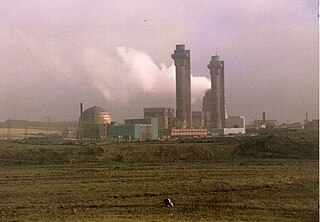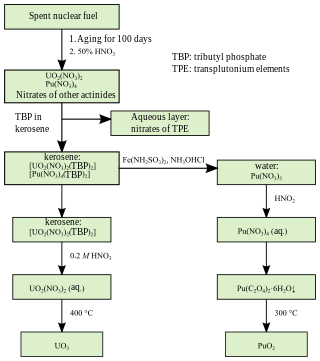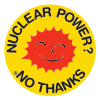
A nuclear meltdown is a severe nuclear reactor accident that results in core damage from overheating. The term nuclear meltdown is not officially defined by the International Atomic Energy Agency or by the United States Nuclear Regulatory Commission. It has been defined to mean the accidental melting of the core of a nuclear reactor, however, and is in common usage a reference to the core's either complete or partial collapse.

Sellafield, formerly known as Windscale, is a large multi-function nuclear site close to Seascale on the coast of Cumbria, England. As of August 2022, primary activities are nuclear waste processing and storage and nuclear decommissioning. Former activities included nuclear power generation from 1956 to 2003, and nuclear fuel reprocessing from 1952 to 2022.

A nuclear and radiation accident is defined by the International Atomic Energy Agency (IAEA) as "an event that has led to significant consequences to people, the environment or the facility. Examples include lethal effects to individuals, large radioactivity release to the environment, reactor core melt." The prime example of a "major nuclear accident" is one in which a reactor core is damaged and significant amounts of radioactive isotopes are released, such as in the Chernobyl disaster in 1986 and Fukushima nuclear disaster in 2011.

Magnox is a type of nuclear power / production reactor that was designed to run on natural uranium with graphite as the moderator and carbon dioxide gas as the heat exchange coolant. It belongs to the wider class of gas-cooled reactors. The name comes from the magnesium-aluminium alloy, used to clad the fuel rods inside the reactor. Like most other "Generation I nuclear reactors", the Magnox was designed with the dual purpose of producing electrical power and plutonium-239 for the nascent nuclear weapons programme in Britain. The name refers specifically to the United Kingdom design but is sometimes used generically to refer to any similar reactor.

Dounreay is a small settlement and the site of two large nuclear establishments on the north coast of Caithness in the Highland area of Scotland. It is on the A836 road nine miles west of Thurso.

The International Nuclear and Radiological Event Scale (INES) was introduced in 1990 by the International Atomic Energy Agency (IAEA) in order to enable prompt communication of safety significant information in case of nuclear accidents.
Nirex was a United Kingdom body set up in 1982 by the UK nuclear industry to examine safe, environmental and economic aspects of deep geological disposal of intermediate-level and low-level radioactive waste (LLRW).

The Nuclear Decommissioning Authority (NDA) is a non-departmental public body of the Department for Energy Security and Net Zero formed by the Energy Act 2004. It evolved from the Coal and Nuclear Liabilities Unit of the Department of Trade and Industry. It came into existence during late 2004, and took on its main functions on 1 April 2005. Its purpose is to deliver the decommissioning and clean-up of the UK's civil nuclear legacy in a safe and cost-effective manner, and where possible to accelerate programmes of work that reduce hazard.

The Windscale fire of 10 October 1957 was the worst nuclear accident in the United Kingdom's history, and one of the worst in the world, ranked in severity at level 5 out of 7 on the International Nuclear Event Scale. The fire was in Unit 1 of the two-pile Windscale site on the north-west coast of England in Cumberland. The two graphite-moderated reactors, referred to at the time as "piles," had been built as part of the British post-war atomic bomb project. Windscale Pile No. 1 was operational in October 1950, followed by Pile No. 2 in June 1951.

PUREX is a chemical method used to purify fuel for nuclear reactors or nuclear weapons. PUREX is the de facto standard aqueous nuclear reprocessing method for the recovery of uranium and plutonium from used nuclear fuel. It is based on liquid–liquid extraction ion-exchange.

The Thermal Oxide Reprocessing Plant, or THORP, is a nuclear fuel reprocessing plant at Sellafield in Cumbria, England. THORP is owned by the Nuclear Decommissioning Authority and operated by Sellafield Ltd.

Nuclear fuel is material used in nuclear power stations to produce heat to power turbines. Heat is created when nuclear fuel undergoes nuclear fission.

The La Hague site is a nuclear fuel reprocessing plant at La Hague on the Cotentin Peninsula in northern France, with the Manche storage centre bordering on it. Operated by Orano, formerly AREVA, and prior to that COGEMA, La Hague has nearly half of the world's light water reactor spent nuclear fuel reprocessing capacity. It has been in operation since 1976, and has a capacity of about 1,700 tonnes per year. It extracts plutonium which is then recycled into MOX fuel at the Marcoule site.
Fallout is a RTÉ two-part fictional, doom laden, docudrama. It deals with the nuclear fallout following a hypothetical disaster in the Sellafield Nuclear Reprocessing Plant in Cumbria on the British coast of the Irish Sea. The docu-drama suggests that, due to a changing wind direction, Ireland would bear the brunt of the British accident. The docu-drama was based on the false premise, that such an accident as depicted in the drama could happen and that parts of Ireland would need to be evacuated following a serious accident at Sellafield. Dr Ann McGarry, chief executive of the Radiological Protection Institute of Ireland, said: "The scenario envisaged in the programme is not realistic and grossly exaggerates the amount of radioactivity that could reach Ireland. The RPII cannot envisage any realistic scenario that would cause the radiation levels in Ireland to reach the concentrations as what was depicted in the drama". Following the dramatized accident, the docu-drama depicts Irish evacuation riots, societal collapse and widespread health impacts.

"Radioactivity" is a song by the German electronic music band Kraftwerk. It was released in May 1976 as the only single from their fifth studio album, Radio-Activity (1975). It sold 500,000 units in France.
Technetium-99 (99Tc) is an isotope of technetium which decays with a half-life of 211,000 years to stable ruthenium-99, emitting beta particles, but no gamma rays. It is the most significant long-lived fission product of uranium fission, producing the largest fraction of the total long-lived radiation emissions of nuclear waste. Technetium-99 has a fission product yield of 6.0507% for thermal neutron fission of uranium-235.
The RadBall is a 140-millimetre (5.5-inch) diameter deployable, passive, non-electrical gamma hot-spot imaging device that offers a 360 degree view of the deployment area. The device is particularly useful in instances where the radiation fields inside a nuclear facility are unknown but required in order to plan a suitable nuclear decommissioning strategy. The device has been developed by the UK's National Nuclear Laboratory and consists of an inner spherical core made of a radiation sensitive material and an outer tungsten based collimation sheath. The device does not require any electrical supply or communication link and can be deployed remotely thus eliminating the need for radiation exposure to personnel. In addition to this, the device has a very wide target dose range of between 2 and 5,000 rads which makes the technology widely applicable to nuclear decommissioning applications.
Jean McSorley is long-standing anti-nuclear campaigner, who formed the group "Cumbrians Against a Radioactive Environment" (Core) from her home town of Barrow-in-Furness, England in protest at the local Sellafield plant. As well as fighting compensation cases for Sellafield workers, Core took part in direct action campaigns. It has been incorrectly reported that they earned a string of injunctions.[1] Neither CORE as a group, nor the individuals involved, have received injunctions; but Greenpeace – who Jean McSorley subsequently worked for - has been served with a number due to its actions against nuclear operations.
Andrew Thomas Blowers is a British geographer and environmentalist and Emeritus Professor of the Faculty of Arts & Social Sciences at the Open University.

Dorothy Anne Gradden OBE is a British Nuclear Engineer for Sellafield Ltd. She leads the projects to decommission the large "legacy" ponds. These are nationally important projects as part of country's nuclear clean up operation on "Britain’s biggest and most hazardous nuclear waste site". In 2017 she was given an OBE and in 2019 the Nuclear Decommissioning Authority recognised her as a role model in their Safety and Wellbeing Awards.














